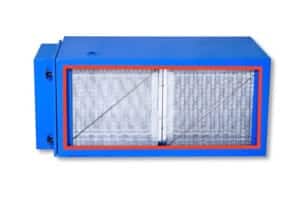The number one rule for electrostatic filtration system is that the higher the velocity, the lower the efficiency.
Please be aware that some vendors claim a higher airflow rate for the same or smaller cell or smaller air intake face area. Hence, requiring a lesser number of ESP units for a required airflow. The problem will be apparent only when the ESP unit is in full operation as inefficiency becomes noticeable in the cooking exhaust systems.

AOS electrostatic precipitator works best between 2-3 m/s for face velocity (marked in red) airflow goes up to 4-5 m/s and at that airspeed efficiency is compromised significantly.
FACE VELOCITY ATTRIBUTES WHEN PURCHASING COMPETITOR’S ESP UNITS
- Size of the face area of the ESP unit compared to competitor’s unit.
- The buyer should consider the size of the electrostatic air filter and pre-filters, smaller physical size will greatly affect efficiency on the ESP unit.
- Do the competitor ESP units have the new updated ASHRAE 52.2 2012 test reports? And the ASHRAE testing is the best way to measure filter efficiency.
- The buyer should count the number of electrostatic cells and pre-filters per ESP unit some competitors would use less amount of electrostatic cells and pre-filters for the equivalent airflow required.
- The buyer should consider the size of the electrostatic cells and pre-filters, smaller physical size will significantly affect efficiency on the ESP unit.
- Do the competitor the electrostatic filtration units have the new updated ASHRAE 52.2 2012 test reports? The ASHRAE testing is the best way to measure filter efficiency.
- The buyer should count the number of electrostatic cells and pre-filters per ESP unit some competitors would use less amount of electrostatic cells and pre-filters for the equivalent airflow require